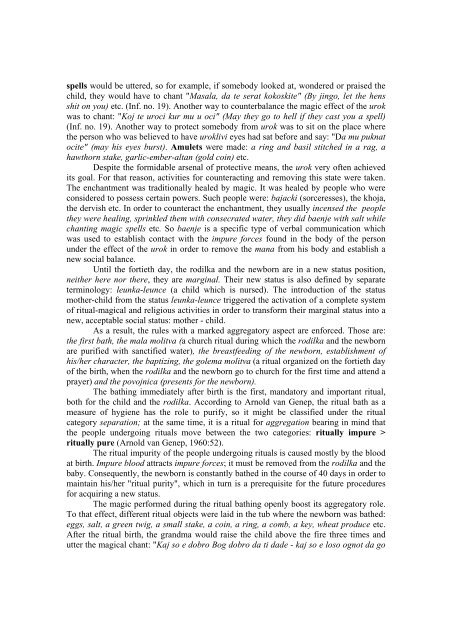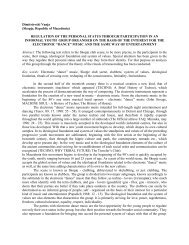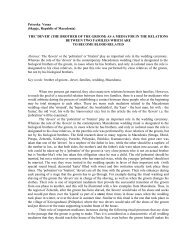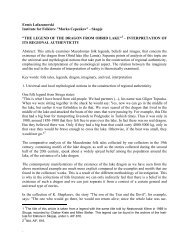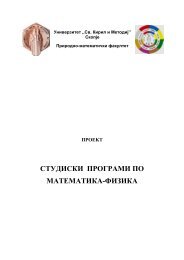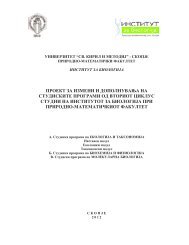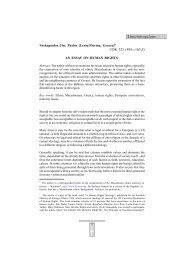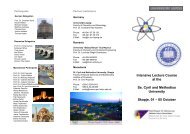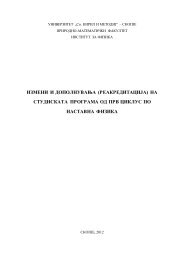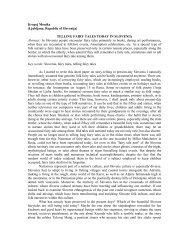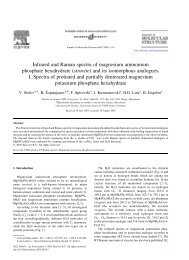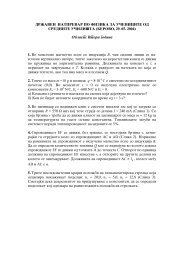Ljupco Nedelkov (Skopje, Macedonia) THE BIRTH RITUAL OF ...
Ljupco Nedelkov (Skopje, Macedonia) THE BIRTH RITUAL OF ...
Ljupco Nedelkov (Skopje, Macedonia) THE BIRTH RITUAL OF ...
Create successful ePaper yourself
Turn your PDF publications into a flip-book with our unique Google optimized e-Paper software.
spells would be uttered, so for example, if somebody looked at, wondered or praised the<br />
child, they would have to chant "Masala, da te serat kokoskite" (By jingo, let the hens<br />
shit on you) etc. (Inf. no. 19). Another way to counterbalance the magic effect of the urok<br />
was to chant: "Koj te uroci kur mu u oci" (May they go to hell if they cast you a spell)<br />
(Inf. no. 19). Another way to protect somebody from urok was to sit on the place where<br />
the person who was believed to have uroklivi eyes had sat before and say: "Da mu puknat<br />
ocite" (may his eyes burst). Amulets were made: a ring and basil stitched in a rag, a<br />
hawthorn stake, garlic-ember-altan (gold coin) etc.<br />
Despite the formidable arsenal of protective means, the urok very often achieved<br />
its goal. For that reason, activities for counteracting and removing this state were taken.<br />
The enchantment was traditionally healed by magic. It was healed by people who were<br />
considered to possess certain powers. Such people were: bajacki (sorceresses), the khoja,<br />
the dervish etc. In order to counteract the enchantment, they usually incensed the people<br />
they were healing, sprinkled them with consecrated water, they did baenje with salt while<br />
chanting magic spells etc. So baenje is a specific type of verbal communication which<br />
was used to establish contact with the impure forces found in the body of the person<br />
under the effect of the urok in order to remove the mana from his body and establish a<br />
new social balance.<br />
Until the fortieth day, the rodilka and the newborn are in a new status position,<br />
neither here nor there, they are marginal. Their new status is also defined by separate<br />
terminology: leunka-leunce (a child which is nursed). The introduction of the status<br />
mother-child from the status leunka-leunce triggered the activation of a complete system<br />
of ritual-magical and religious activities in order to transform their marginal status into a<br />
new, acceptable social status: mother - child.<br />
As a result, the rules with a marked aggregatory aspect are enforced. Those are:<br />
the first bath, the mala molitva (a church ritual during which the rodilka and the newborn<br />
are purified with sanctified water), the breastfeeding of the newborn, establishment of<br />
his/her character, the baptizing, the golema molitva (a ritual organized on the fortieth day<br />
of the birth, when the rodilka and the newborn go to church for the first time and attend a<br />
prayer) and the povojnica (presents for the newborn).<br />
The bathing immediately after birth is the first, mandatory and important ritual,<br />
both for the child and the rodilka. According to Arnold van Genep, the ritual bath as a<br />
measure of hygiene has the role to purify, so it might be classified under the ritual<br />
category separation; at the same time, it is a ritual for aggregation bearing in mind that<br />
the people undergoing rituals move between the two categories: ritually impure ><br />
ritually pure (Arnold van Genep, 1960:52).<br />
The ritual impurity of the people undergoing rituals is caused mostly by the blood<br />
at birth. Impure blood attracts impure forces; it must be removed from the rodilka and the<br />
baby. Consequently, the newborn is constantly bathed in the course of 40 days in order to<br />
maintain his/her "ritual purity", which in turn is a prerequisite for the future procedures<br />
for acquiring a new status.<br />
The magic performed during the ritual bathing openly boost its aggregatory role.<br />
To that effect, different ritual objects were laid in the tub where the newborn was bathed:<br />
eggs, salt, a green twig, a small stake, a coin, a ring, a comb, a key, wheat produce etc.<br />
After the ritual birth, the grandma would raise the child above the fire three times and<br />
utter the magical chant: "Kaj so e dobro Bog dobro da ti dade - kaj so e loso ognot da go


